| Vintage Pulp | Feb 12 2024 |

1959 flood thriller proves that even during a natural disaster money, booze, and women are all that matter.
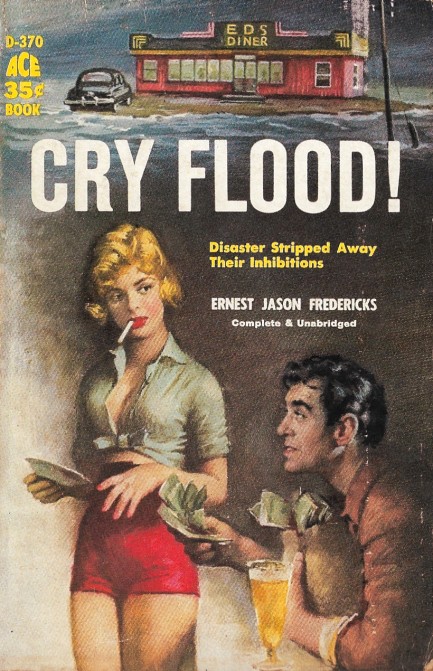
Ernest Jason Fredericks', aka Paul Ernst's 1959 novel Cry Flood!, for which see an Ace paperback edition above with nice art by George Ziel, is a thriller in the flood/hurricane sub-genre on which we've gotten hooked in recent years. We've read entires from John D. MacDonald, Theodore Pratt, Malcolm Douglas, and others. It seems as though the close quarters and ticking clock aspects built into disaster settings bring out the best in authors.
In Cry Flood! Fredericks sets the action in a New Jersey diner perched on high land as two hurricanes to the south and unseasonable rain in the region bring the nearby river to the record crest of a 1936 flood—then beyond. Converging on the diner are a bank-phobic miser carrying twenty-six thousand dollars, four married couples, and two criminals who catch wind of the money and intend to steal it. The problem is the flood waters rise too high for anyone to leave, which means the crooks must bide their time, prompting them to spend it terrorizing those with whom they're trapped.
In Fredericks' hands, the two bad men are synonymous with the flood, implacable and unavoidable, forcing the couples to face their fears and admit their failings before death sweeps them away. Or not—but only if they're brave and lucky. It was quite well done, and consistently enjoyable. For our money, the best of the flood/hurricane lot so far has been John and Ward Hawkins' A Girl, a River, and a Man, but Cry Flood! held its own in what has continued to be fertile pop fiction territory.
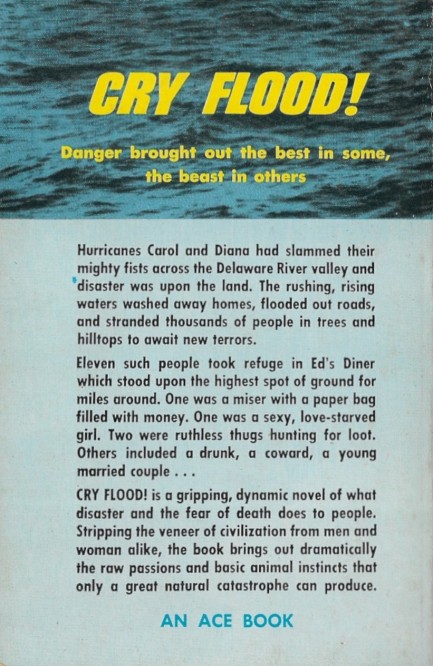

| Vintage Pulp | Oct 29 2022 |

Cushman's ideas about Indonesia make for an uneven mix.
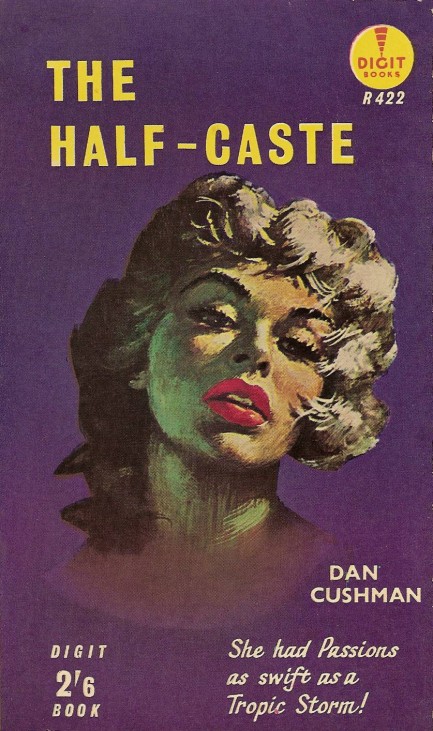
Above is a nice piece of George Ziel art we found on Flickr for Dan Cushman's The Half-Caste, a book we discussed not long ago. The character referred to by the title is a white woman with a Pacific Islander admixture that only a few can discern, but those who do discern it like the way it looks. Thus, even though The Half-Caste has a title that suggests a tale with sociological musings, it's nothing of the sort. It's an Indonesian island adventure of the usual type, and one that could be better. But Ziel's purple art is cool.
| Vintage Pulp | Feb 25 2018 |

Chester Himes' tough love affair with Harlem continues.
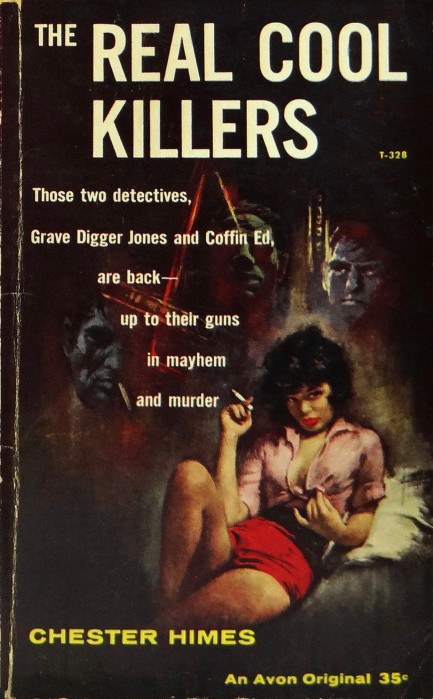
A beautiful piece of George Ziel art fronts this Avon paperback edition of the Chester Himes' thriller The Real Cool Killers. The story here takes place during one night, as a white man is shot in the back on a Harlem street and the detective duo Gravedigger Jones and Coffin Ed make the scene. Ed goes off his head and is suspended, which makes 90% of the book Gravedigger's show. Was the victim an innocent bystander? Was the murderer who it seems to be? And what does Coffin Ed's daughter have to do with it?
Himes' descriptive flair is unique, his sense of place is vivid, his use of language is a highwire act, and his characters are interesting. Even their names are often amazing—Ulysses Galen, Sugartit, Shiek, etc. The Real Cool Killers appeared in 1959, and as we noted when read The Crazy Kill, we're struck by the fact that—in that charged cultural era on the cusp of the Civil Rights Movement—Himes doesn't bother writing a single sympathetic black character aside from his two cops. But in this way he's no different than other hard-boiled crime writers.
Himes moved black characters to the center. They drive the action from all sides rather than are merely affected by it. Research shows that books, films, and television shows in which black characters drive rather than are affected by the action tend to be less popular with white Americans. Seen in that light, Himes' success is a tribute to a unique skill set. In the same way the murdered man in The Real Cool Killers gets his thrills going to Harlem, readers in 1959 were able to visit a world not their own in Himes' fiction. He's more than just a real cool writer. He's a pioneer.
Himes' descriptive flair is unique, his sense of place is vivid, his use of language is a highwire act, and his characters are interesting. Even their names are often amazing—Ulysses Galen, Sugartit, Shiek, etc. The Real Cool Killers appeared in 1959, and as we noted when read The Crazy Kill, we're struck by the fact that—in that charged cultural era on the cusp of the Civil Rights Movement—Himes doesn't bother writing a single sympathetic black character aside from his two cops. But in this way he's no different than other hard-boiled crime writers.
Himes moved black characters to the center. They drive the action from all sides rather than are merely affected by it. Research shows that books, films, and television shows in which black characters drive rather than are affected by the action tend to be less popular with white Americans. Seen in that light, Himes' success is a tribute to a unique skill set. In the same way the murdered man in The Real Cool Killers gets his thrills going to Harlem, readers in 1959 were able to visit a world not their own in Himes' fiction. He's more than just a real cool writer. He's a pioneer.
| Vintage Pulp | Sep 27 2017 |

Mess with a man and you've got a problem. Mess with his money and you've got a murder.
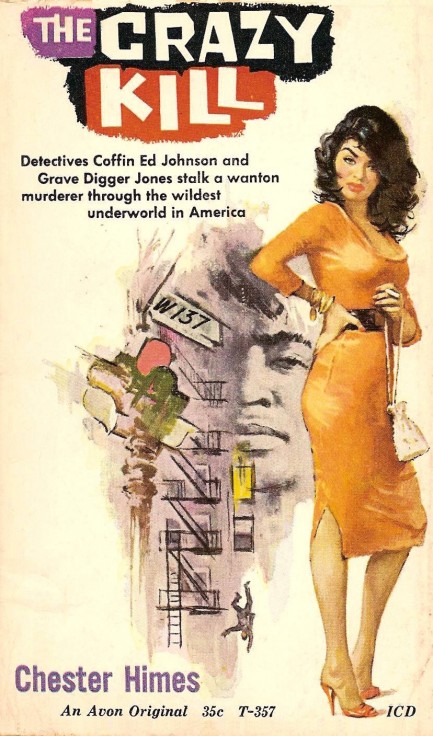
Above is a cover for The Crazy Kill, by Chester Himes, 1959, with beautiful art by George Ziel, someone we've technically never featured before, but who did a lot of work for Avon. We say we haven't technically featured him, but he painted the femme fatale at the top right of our webpage. It comes from a paperback by Bonnie Golightly called The Wild One. So in a sense we've showcased him every day for many years. And even more interestingly, when we narrowed down the various femmes fatales we were considering using in the site design, we ended up with three, one of which was the figure on the cover of The Crazy Kill. Not sure why we didn't choose her. In any case, we've had an affinity for Ziel's work for a long time.
And we've had an interest in Chester Himes for a while too. The Crazy Kill was our first Himes novel but it probably won't be our last. The book wasn't perfect, though. While the Harlem setting provides good atmosphere, the professional gamblers peopling the narrative are fascinating, and the two detectives Coffin Ed Johnson and Gravedigger Jones are about as expected, the overall lack of sympathetic characters threw us a bit. In fact, we didn't like the two cops much either, but one scene won us over. During a previous investigation Ed had acid thrown in his face and was terribly scarred. But he presents an unfailingly tough façade—until a crook tells him he looks like Frankenstein's monster. Ed flies into a rage and beats the man, but then comes this:
Coffin Ed stuck his pistol back into the holster, turned and left the room without uttering a word, stood for a moment in the corridor and cried.
It turns out Ed is human after all, and from that point it was easier for us to be on his side. Though the writing has its flaws in our opinion, a central mystery that probably only Himes could have come up with kept us forging ahead: a preacher falls out of an apartment building window but lands in a bread basket, the type bakeries once used to deliver large orders. The preacher is fine and returns to the building, but somehow another man is found dead minutes later in the same bread basket. How he got there and why is utterly baffling. The Crazy Kill is weird, but fun and worth a read. In the meantime we may go back to the first Coffin Ed/Gravedigger Jones book For Love of Imabelle to see what these guys are all about.
| Vintage Pulp | Oct 1 2010 |

Silly boys. I wonder if they'd be fighting if they knew that no matter who wins I'm going to lei them both.

This cover for Ed Lacy's 1960 novel South Pacific Affair makes us suspect artist George Ziel was thinking along the same lines as us—i.e. it's interesting that he painted the island woman with two leis around her neck. Here's a fun fact: while we know several people, us included, who've come to the physical defense of women in danger, we don't know a single man who's ever fought due to romantic rivalry. We asked around. Nobody admitted to it. Is it generational? Every woman we know would stop this fight in its tracks with: “Hey! Idiots! I'm not a 24-pack of Coors! I choose, and it's neither of you!” But the cover misleads, as they sometimes do. There's no literal fight over a woman. There's a fight over a sexual betrayal, but the catalyst is years in the past and 7,000 miles away.
We've read a few Ed Lacy books, and all of them have been about crime and graft in urban settings. South Pacific Affair expands his field of interests to the classic fantasy of life in paradise. Ray Jundson is an American living on the fictional French Polynesian island of Numaga who can't see the beauty of his circumstances. He's torn between staying there, continuing to sail from island to island trading goods, and marrying his island sweetheart Ruita, or letting his wanderlust and desire for riches carry him away toward unknown solo adventures, possibly even back to the U.S. Frankly, for a man with everything he's way too jaded for realism, but you have to follow the author's lead.
We don't know if Lacy ever went to French Polynesia, but the details read as if he did. That's good, because other than travelogue, nudity, and a lot of soul searching by Ray, nothing much happens in the book until, more than halfway through, a smallpox outbreak brings on a countrywide quarantine. One captain defies the law, sails from Papeete to Numaga, and tries to offload passengers, while downplaying the severity of the disease. That's on-the-nose for 2020, don't you think? Turns out he's actually trying to jettison a group of advanced cases and Ray is one of the people fate places in a position to stop this deadly maneuver.
This is Ray's first motivated act in the entire book, but fortunately not his last, which means the final third of the story gets interesting. Too bad that newly found motivation leads him to set up a scam involving a fake Polynesian princess, credulous American tourists, and the island equivalent of pimping. It may sound farfetched, but we can tell you from personal experience: spend enough time on a tropical island and anything can seem like a good idea. South Pacific Affair isn't Lacy at his best, but for knockaround guys like us, it was pleasantly familiar. Overall, we think it's worth reading for its unusual status in the Lacy bibliography. But we offer no guarantees.




































































